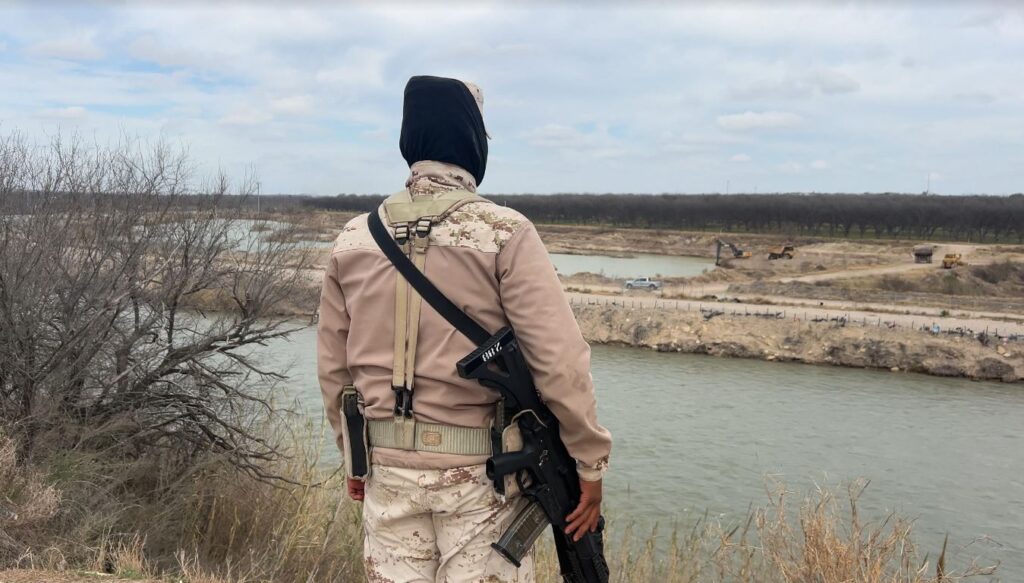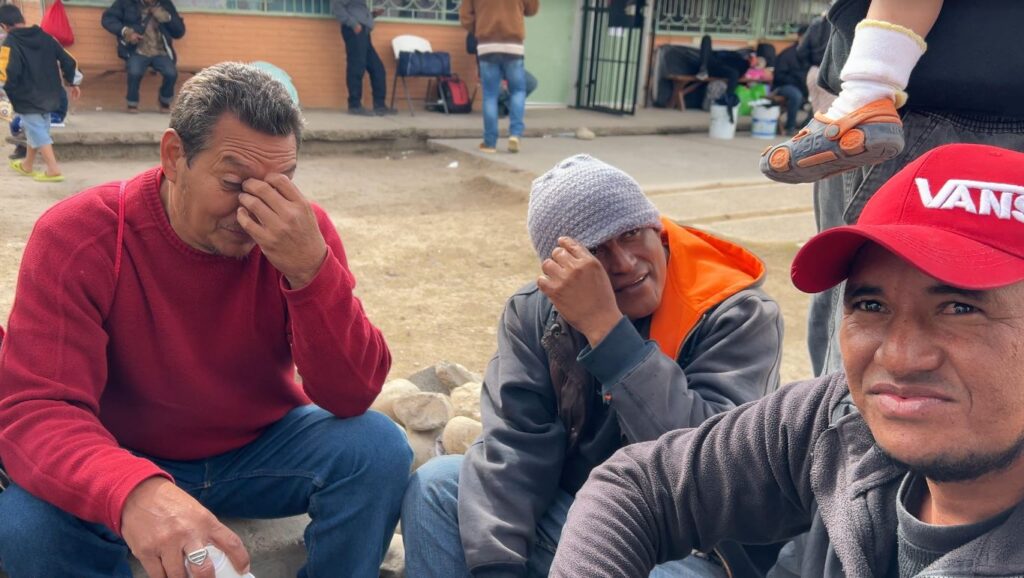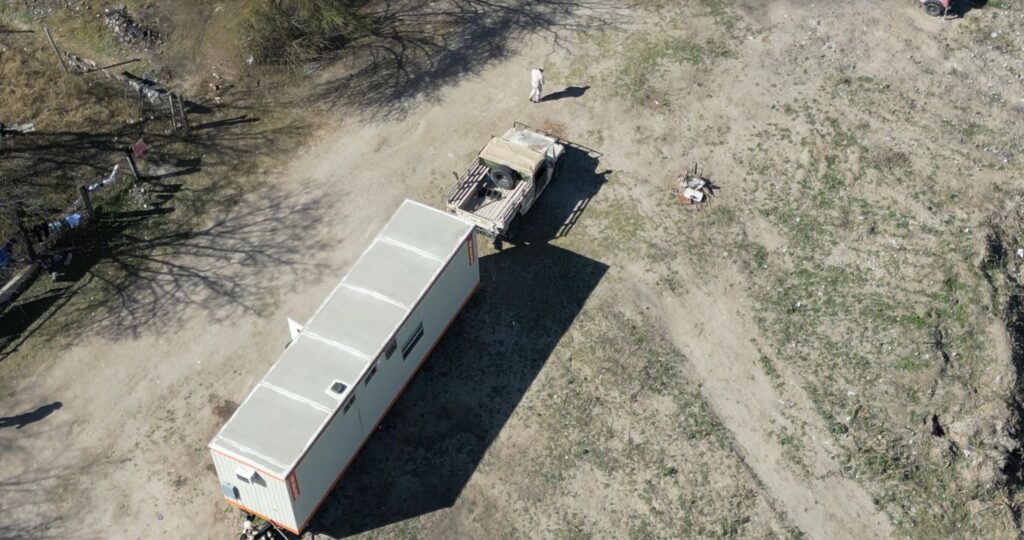
Mexican soldiers like this one across from Eagle Pass Texas say their orders are to round up immigrants in Piedras Negras for 1,500-mile deportations to Mexico’s far south. Photo by Todd Bensman
By Todd Bensman as published February 14, 2024 by the Center for Immigration Studies
A modified version of this story, with video, was published February 11, 2024 by The Daily Mail
PIEDRAS NEGRAS, Mexico — Just a month or two ago, thousands of economic immigrants a day launching illegal crossings from this Mexican city over the Rio Grande into Eagle Pass, Texas submerged U.S. Border Patrol and Texas State military forces, mesmerized the international media, and – significantly – pounded Joe Biden’s re-election poll numbers.
But because the Biden campaign simply could not brook the bad polling part, the last and only immigrants who can be found anywhere in Piedras Negras today cower in fear behind the skirts of Catholic nuns inside the tall barbed-wire-rimmed compound of a Catholic Diocese-run shelter called Casa Del Migrantes. The roughly 200 inside are hounded by a suddenly wider-than-usual assortment of predatory Mexican army, state police, and national immigration service predators hunting them down to forcibly transport them 1,500 miles into southern Mexico to a new kind of Gaza Strip along the Guatemala border.
“We’re protected only inside the shelter,” one of six Central American men among the Venezuelans, Colombians, and Ecuadorans said in explaining why none dare to even step foot outside to buy snacks at a store across the street. “Out on the street, they can capture us. But they cannot come in here.”

Mexican soldiers like this one across from Eagle Pass Texas say their orders are to round up immigrants in Piedras Negras for 1,500-mile deportations to Mexico’s far south.
Where just weeks ago, U.S.-bound immigrants were publicly ubiquitous all the time, the streets are now devoid of them, and only a few dozen a day attempt desperate clandestine crossings on new flanking paths that smugglers have blazed in the broader Eagle Pass area. Texas crossings are now far less than Arizona and California for the first time in the three-year-long historic crisis.
“They are protecting themselves,” Sister Isabel Turcios, shelter director, said of her charges, whom she knows will at some point make a once-only desperate break through Biden’s Mexico-side cordon. “Especially because they have children. The mothers cannot be in the streets with children.”
Sister Turcios knows she is sheltering intending U.S. border crossers from what she calls “persecution by Mexican immigration.” Her competitive advantage, she said, is that Mexican law prevents them from entering a religious facility like hers to round up immigrants. It turns out that Biden never needed a Senate bill deal to do something real about the three-year-long mass migration crisis.

So what exactly happened to so flip the tables only a month after record-smashing crossings into Texas and other states that were reaching 12,000 and 14,000 every day border-length and is now around a less media-appealing 5,000 or 6,000 a day? And what took him so long to order up the easiest obvious partial fix? One answer is media coverage and polling. President Biden, facing devastating poll numbers from the fall months’ escalated catastrophe, somehow maneuvered Mexico President Manuel Lopez-Obrador into doing the dirty work necessary on his side to quickly calm the most camera-visible chaos on the American side.
After Biden and his chief lieutenants returned from mysterious diplomatic missions to Mexico City in late December with a still-secret deal in hand, Mexico’s central government mounted one of the most epic domestic anti-illegal immigration operations in recent memory. Some of the operations done at Biden’s behest have proven ruthless.
At Biden’s apparent urging, the Mexican army, national guard, Mexican immigration officers rushed into the northern borderlands just after Christmas and, with state police, began rounding up tens of thousands of immigrants in Piedras Negras and many other cities. They force fed these thousands into a conveyor belt of government buses and airplanes delivering them to Mexico’s farthest southern provinces along the border with Guatemala, especially the cities of Villahermosa and Tapachula. And blocks them there with bureaucracy and new road checkpoints that filter for immigrant riders.
In emblematic Piedras Negras, known to the Mexican troops as “Zone 47,” soldiers in early January were filling 10 buses a day and up to 30 passenger jets with rounded-up immigrants. “The hardest thing to find in Piedras Negras now…” observed local journalist Efraim Gonzalez as we cruised around town in his car… “is a migrant.”
Gonzalez was driving me on a long totally empty dirt track, playing video on his phone showing the very same road clogged with thousands of immigrants.
“The Border Patrol was lifting the barbed wire for the immigrants,” on the other side,” he recalled. But Gov. Greg Abbott seized that area of Eagle Pass and kicked out the Border Patrol. Now with the Mexicans also cracking down on this side, “It’s like magic,” Gonzalez said as we drove eventually to a Mexican military outpost where four soldiers stood guard at the trash-strewn river crossing.
Importantly to all of this, troops and state police – finally, for the first time in the three-year mass immigration crisis – now roust and block immigrants farther south from free rides atop Mexico’s “La Bestia” cargo trains, a tactic that both the Biden and Lopez-Obrador administrations wittingly allowed, as I first reported a year ago in a special report for the The Daily Mail. The Mexican press is reporting operations in Tijuana, Juarez, and Matamoros, where the military recently bulldozed a massive immigrant camp across from Brownsville and dug anti-pedestrian trenches, “under U.S. pressure,” one Mexican newspaper reported.
Some of what Mexico is doing for Biden would alienate his progressive liberal voting base if American media would cover any of it.State police in Coahuila, for instance, where Piedras Negras is situated, are in charge of pulling immigrants from the freight trains. They often use rough or even violent tactics to pull women, children, and men from atop the freight cars, said Mexican journalist Auden Cabello, who has interviewed immigrants pulled from the trains.
“The force that they’re describing is that they’re being pulled off the trains after not obeying demands,” Cabello said. “That’s everybody, women and children, men… they’re physically dragging them off the trains.”
This unparalleled Mexican operation demonstrates that President Biden in one single move could have significantly eased the three-year-old mass migration crisis any time he felt like making a trip to Mexico, contrary to his public assertions that he needed legislation to do anything.
Nonetheless, the tactics are having real impact on the border crisis, showing that Biden all along
could have leveraged Mexico to do this work. Simple economics explain why the crackdown is
working and would have worked all along, the immigrants cowering inside Casa de
Migrante allow.
They do not so much fear authorities roughing them up as that the one-way trip to entrapment in Villahermosa and Tapachula would cement the loss of thousands of dollars they spent on smugglers getting this far north.
The men offered that they’d invested from $1,700 to $10,000 making it to Piedras Negras.
“We don’t have money now. We’ve already spent everything on our journey to arrive here,” one of the Central Americans said, the others nodding in agreement. “We would have to start from zero.”
Which plays into another of the Mexican tactics. The free-ride freight train system is no longer available to them. Now, only the wealthiest would be able to afford now very pricey smugglers in private transports that must still somehow evade northern roadblocks, six alone between the city of Monterrey and Piedras Negras, Sister Turcios said.
Mexico, of course, has deployed its military and national guard to the border in recent years past and conducted semblances of roundups for deportation to southern provinces. But this one seems longer term than previous operations. For one, the soldiers come equipped with mobile living quarters, trailers on wheels, that can sleep up to 20 at a time.

These have been wheeled up and placed at intervals for miles along the Rio Grande in at least Zone 47.
One source with access to senior U.S. Customs and Border Protection told me the Mexican operation is set to last until after the American election, although this is uncorroborated. The soldiers weren’t talkative when I would pull up on them. But some reluctantly answered questions. What are their orders? Find immigrants and turn them over the the immigration service for shipment to Mexico’s
south.
How long is this deployment?
Answer: “No ending point.